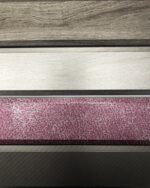Mimicking Other Materials with In-Mold Labeling
May 20, 2022 • Posted in In Mold Labeling
From marble to granite to wood-trim, we offer nearly endless options to create plastic parts and pieces that look like the real thing — aka, natural materials. By using in-house techniques that have been refined over 40 years, we’re able to mimic the look of rock, wood, and metal with in-mold labeling (IML), fine expression screen printing (FESP), and physical vapor deposition (PVD) capabilities.

Why opt for IML parts?
While visual accents like wood grain or carbon fiber can feel synonymous with luxury for consumers, the truth is that those materials can be cost or weight prohibitive for manufacturers. There are also several safety factors to consider, as well as the moldability and durability of natural materials.
If we look at wood grain as an example — wood inlays are used to give auto interiors and appliances a warm, rich feel. There are several limitations to using real wood, however. One can be the direction of the wood grain, depending on the orientation of the part and species of wood selected. Another can be weight — many cars, especially electric vehicles (EV), are looking to reduce weight to improve driving range. Real wood can eventually splinter, fade, and become susceptible to water or UV damage over time.
Many manufacturers have strict testing protocols and standards that must be met before a final product (like a car or washing machine) goes into full production. While some natural materials are unable to meet those standards, oftentimes an IML product can.
Those stringent standards might include:
Chemical resistance
UV resistance
Durability
Water resistance
Flammability
And more…

Which materials can be mimicked with IML?
Wood Grain
There are two methods available for creating a wood grain look. One is standard IML, where the manufacturer prints on the B-side of a part to create a pattern that’s glossy and finished on the front. Another option is surface printing with FESP, which reduces the gloss and gives the part a natural, textured feel.

Chrome
Chrome is a popular accent for highlighting parts that grab attention, like emblems or decals. At Sanwa, designs we’ve molded include long accent strips that highlight a part or window, and chrome-looking frames that call attention to specific functions (like dashboards or buttons). If a brighter-looking chrome is desired, we can also offer PVD coating to enhance the look and hardiness of a part.
Stainless Steel
While stainless steel is popular for appliances, many manufacturers actually use IML to achieve the look and meet testing and weight standards. An IML manufacturer can imitate stainless steel in two ways — one is to brush or scratch the film to create a brushed pattern, and the other is to print a brushed pattern. Additionally, both methods can be combined with chrome printing to create a high-end looking panel.
Rock & Stone
Natural stones like granite and marble may be desirable for consumers, while being costly or too heavy for manufacturers’ designs. IML offers the ability to print copycat patterns that achieve that same sheen and richness, while staying within a product’s weight, durability, and cost guidelines.

Brush Stroke & Leather
Brushing and texture can give a product depth and even hide flaws over long-term use. At Sanwa, we also have the ability to do selective brushing or printing. For example, a dashboard with a clear LCD screen might require brushing around the frame, but not through the transparent window. While many companies aren’t able to stop brushing at certain areas of a single sheet of film, we are able to brush around clear windows, buttons, and more.
Custom Designs
IML printing doesn’t stop at mimicking materials — it can also be used to create limited edition designs and graphics. Since the artwork is printed directly onto a plastic part, manufacturers don’t have to worry about wear and tear over time, like they might with post-production adhesives. This is where design teams can get creative, and even offer small-lot versions of their product (like this Statue of Liberty edition appliance!).

Bring other materials to life with IML
There are few limits when it comes to mimicking natural materials with IML — or even several materials within one part. If you’re interested in learning more about our IML, printing, or PVD/sputtering capabilities, we invite you to contact us. Our team is happy to work with you to pinpoint your best-fit options and bring your big design ideas to life.